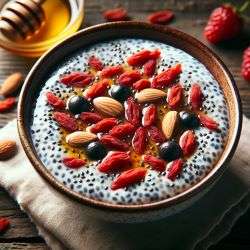This post contains affiliate links, through which we may earn a commission at no additional cost to you.
Table of Contents
Introduction
In our journey towards a lifestyle that prioritizes sustainability and awareness of our ecological footprint, the eco-friendly garden is an ideal platform to showcase our dedication to preserving the environment. There exist countless strategies for fostering a verdant retreat. Still, the incorporation of berry plants emerges as a highlight for their abundant harvests and their role in cultivating an environmentally harmonious garden. “Top 4 Types of Berries for Green Garden Landscapes” presents a selection of berries that flourish with little human interference, bolster local wildlife and plant diversity, and provide delicious benefits.
This resource sheds light on four distinct berries—the famous and cherished strawberry, the hardy lingonberry, the indigenous huckleberry, and the nutrient-dense goji berry—selected for their positive impact on the environment, low-maintenance Care and the tasty bounty they contribute to our diets. This guide aims to assist both experienced gardeners looking to enhance their eco-friendly practices and beginners seeking sustainable gardening options. It offers these four berries as a flavorful avenue for cultivating a garden that aligns with ecological values.
Strawberry: The Sweetheart of the Garden
Welcome to the yummy world of strawberries, the red ruby gemstones of your garden. They have many people’s hearts. Not only are strawberries a sight for sore eyes, but their ability to be used in many ways in the kitchen makes them a loved choice among those who love cooking. Let’s go on a trip to learn everything about growing strawberries and the climate they love, and also explore yummy recipes, homemade items, and health food items available in the market.
How to Grow and Take Care
Strawberries are true stars and need full sun to grow their sweetest fruits. These garden divas flourish in well-drained, sandy loam soil with a pH between 5.5 and 6.8. To avoid diseases caused by fungus, good air circulation around them should be ensured. Using straw to mulch can retain moisture, keep weeds away, and keep the berries clean. Regular watering is essential, especially during dry times and when growing fruits. However, avoid watering from above to prevent diseases in leaves and rotting of berries. For a considerable harvest, choose a strain that suits your climate and consider planting in raised beds or pots to improve water drainage and foil strawberry-loving pests.
Appropriate Climate for the Best Types of Berries
Strawberries are comfortable in a wide range and can be grown in medium to hot climates. USDA zones 3 to 10 are ideal. They like a little chill during the winter to reset their fruiting cycle, and they appreciate a respite from the harsh midsummer heat. In cooler climates, planting at the beginning of Spring as soon as the soil begins to work will yield a summer harvest in warmer regions. For winter harvest, strawberries should be planting during the fall season.. To spring harvest. The key is to choose a strain that matches your local weather – June-bearing for temperate zones, everbearing and day-neutral pressures for areas with gentle winters.
Tasty and Nutritious Recipes
- Strawberry and Basil Salad
- Mix the fresh, peppery flavor of arugula with sliced strawberries, a sprinkle of feta cheese, and toasted pine nuts.
- Dress it with a balsamic reduction infused with fresh basil for a refreshing salad full of nutrients that symbolize summer.
- Strawberry Chia Seed Pudding
- Combine chia seeds with almond milk, a bit of vanilla extract, and honey as per taste.
- Let it sit in the refrigerator overnight.
- Layer the pudding with fresh strawberries and a spoonful of Greek yogurt for breakfast or dessert that will sparkle like a rainbow on a sunny day, offering a generous dose of omega-3s, protein, and antioxidants.

Do-it-Yourself Strawberry Items
- Strawberry Jam
- Get summer’s essence by melting strawberries with sugar and a squeeze of lemon juice!
- Use pectin for a more defined set, or keep it natural for rustic, spreadable jam.
- Perfect for morning toasts, scones, or as a sweet glaze on grilled meats.
- Strawberry Lip Balm
- You must melt beeswax, coconut oil, and shea butter in a double boiler,
- Then add a puree of fresh strawberries for a hint of color and natural sweetness.
- Pour it into small containers and let it sit to get a kiss of summer on your lips throughout the year.
Healthy Food Products
- Organic Freeze-Dried Strawberries
- It is perfect for a crunchy snack! They are full of vitamins and have no added sugar; they retain most of their nutrients, making them a healthy option when you’re in a rush.
- Strawberry Flavored Probiotic Gummies
- This combines the benefits of probiotics for gut health with the irresistible taste of strawberries. These gummies provide a fun way to support your digestive system and are often loved by children and adults.
Growing strawberries in your garden or containers on a porch or patio is a fantastic experience. With appropriate Care, they will provide a large harvest that you can enjoy fresh, in recipes, or preserved as jams and other products. Beyond their delicious taste, strawberries are full of health benefits, making them an excellent choice for a healthy diet. Whether preparing a quick salad, spoiling yourself with a homemade dessert, or choosing healthy food items from the shop, strawberries provide a hint of sweetness and a burst of nutrition to your day.
Lingonberry: The Stalwart of the North
In the revered realm of gardening treasures, lingonberries occupy a cherished niche. Celebrated for their resilience and the tangy, vivid fruits they bear, these plants have the power to turn a simple garden into a haven reminiscent of the Nordic wilds. Cultivating lingonberries offers both the experienced and the curious beginner gardener a mix of botanical challenges and gastronomic opportunities.
Growth Tips and Care
Lingonberries, favoring the cooler temperatures, stand as the hardy warriors of the berry kingdom—sturdy, tenacious, and adept at thriving in suboptimal conditions. Native to the northern hemisphere’s forests, they flourish in USDA zones 2 to 7, ideally suited for gardens that see cooler summers and severe winters.
- Optimal Growing Conditions
- Preferring a more relaxed atmosphere, lingonberry plants excel in environments resembling indigenous Scandinavian woodlands. They thrive in excellent, moist, well-draining, acidic soil (pH 4.5 to 5.5). While they enjoy sunlight, they benefit from afternoon shade, particularly in regions with harsh summer rays.
- Planting and Upkeep
- To maximize the potential of your lingonberries, position them where they can bask in full to partial sun. Being naturally accustomed to the understory of forests, they manage well with a bit of shelter during the peak sun hours. Ensuring they receive ample water is critical to developing a solid root network, especially during their initial growth year. Utilizing pine needles or wood chips as mulch aids in preserving soil moisture and acidity levels.
- Pruning and Gathering
- Lingonberries hardly need much pruning. Remove any dead or broken branches in early Spring, and consider a gentle trim to promote fuller growth. The harvest period spans from the late summer into early autumn, with the fruits turning a rich red as they ripen. A single plant has the potential to produce up to 1.5 kg of berries in ideal conditions.
Nutritious Recipes
Not only do lingonberries come with a unique flavor profile, but they are also loaded with health benefits. These types of berries are a true nutritional gem and rich in antioxidants, plus vitamins C and E, and dietary fiber. Below are two recipes that highlight their distinctive taste and healthful properties:
Lingonberry Smoothie
Ingredients:
1 cup fresh or frozen lingonberries
1 banana
½ cup Greek yogurt
1 tablespoon honey (adjust based on preference)
½ cup almond milk
A dash of ground cinnamon
Instructions:
Blend all the ingredients until smooth.
Modify the level of sweetness by adding honey according to your preference.
Adding a sprinkle of cinnamon before serving will give it that extra zing.
This smoothie offers a delightful refreshment and a boost of vitamins, promoting digestive health and energizing your day.
Lingonberry Vinaigrette
Ingredients:
½ cup lingonberries
¼ cup olive oil
2 tablespoons apple cider vinegar
1 teaspoon Dijon mustard
1 tablespoon maple syrup
Salt and pepper, to taste
Instructions:
Crush the lingonberries in a bowl.
Mix in the olive oil, apple cider vinegar, Dijon mustard, and maple syrup.
Combine thoroughly.
Add salt and pepper as needed.
Top your preferred salad with this vinaigrette for a splendid fusion of flavors.
Crafty Products
- Lingonberry Jam
- A go-to in Scandinavian kitchens, crafting lingonberry jam is straightforward and adapts well to various dishes. Cook lingonberries with sugar and a splash of water until thick. It suits perfectly with meats, cheeses or spread over toast for a quick delicacy.
- Lingonberry Sauce
- Perfect with game or poultry, crafting a lingonberry sauce infused with a touch of orange zest and a splash of red wine can enhance any dish. Its acidity balances the richness of meats, offering an impeccable flavor harmony.
Health Food Options
- Lingonberry Supplement Capsules
- Supplement capsules present an easy alternative for those desiring the antioxidant benefits of lingonberries minus the kitchen work. They provide a straightforward method to integrate lingonberries into your diet, aiding in immune support and possibly diminishing inflammation.
- Lingonberry Powder
- Freeze-dried lingonberry powder preserves most of the fruit’s nutritional value and can be added to smoothies, yogurts, or oatmeal for a healthy lift.
Lingonberries, celebrated for their resilience and remarkable health advantages, invite gardeners and culinary enthusiasts to explore the bold flavors and landscapes of the north. From the satisfaction of nurturing these robust plants to their prompt culinary discoveries, lingonberries offer a decadent journey into the essence of gardening and gourmet experiences. Thus, delve into the northerner spirit and allow the lingonberry to transform your garden—and taste buds—into a realm of vibrant tastes and wholesome living.
Huckleberry: The Hidden Gem
Tucked away in the wilderness’s embrace, under the canopy where the air is as crisp as the dawn’s first light, thrives an unsung hero—the huckleberry. This hidden gem, often eclipsed by its berry counterparts, possesses a rich palette of flavors, numerous health advantages, and a multitude of uses that can revolutionize any kitchen or garden. Join us as we explore the secrets to cultivating, relishing, and reaping the rewards of huckleberries.
Cultivation Insights and Care
Huckleberries are the explorers among types of berries, choosing the path less taken—or the ground less cultivated in this context. Thriving in climates with a freezing winter and a temperate to warm summer, they find zones 3 through 7 their haven. Yet, these berries have particular demands for their prosperity:
- Soil: Acidic soils, boasting a pH level between 4.5 to 6, are their preference. This acidity is the key to their growth success, placing them as the Goldilocks in the berry family—neither too alkaline nor neutral, but perfectly in-between.
- Sunlight: They strike a balance between partial shade and total sun exposure. Reveling in the sun’s embrace, they seek respite in the cooler, shaded parts during the day’s peak temperatures.
- Water: Ensuring the soil remains uniformly moist without being soggy is crucial. Imagine providing a consistent water source to keep them well-hydrated, particularly during drought.
Perfect Climate
Huckleberries RSVP best to cooler climates. They prefer wearing a light jacket over donning shorts, thriving in calm, damp surroundings, especially those at higher altitudes or northern regions. They exemplify the essence of “staying chill.”
Nutritious Recipes
- Heavenly Huckleberry Smoothie
- Mix 1 cup of huckleberries, fresh or frozen, 1 banana, ½ cup of Greek yogurt, and a touch of almond milk for a creamy, nutrient-rich start to your day.
- This smoothie delights the palate while being a powerhouse of antioxidants, fiber, and protein.
- Salad with a Wild Twist
- Combine mixed greens, sliced avocados, feta cheese, toasted walnuts, and a generous helping of huckleberries.
- Finish with a splash of balsamic vinaigrette for a nutrient-rich salad packed with vitamins C and K, fiber, and omega-3 fatty acids.

Homemade Huckleberry Delights
- Huckleberry Jam
- Encase the wild’s essence within a jar by simmering huckleberries with sugar and a hint of lemon juice until it thickens.
- This jam serves as the quintessential manner to preserve summer’s flavors and relish the antioxidant benefits of huckleberries all year long.
- Huckleberry Syrup
- Elevate your pancakes or waffles with syrup by reducing huckleberries with sugar and a bit of water, introducing a flavorful twist to your morning meals and an antioxidant boost.
Health-Promoting Products
- Huckleberry Tea
- For those on the lookout, huckleberry tea merges the berry’s tangy taste with the gains of antioxidants and essential vitamins.
- It’s an ideal beverage for soothing nights.
- Huckleberry Supplements
- Capturing the health benefits in an easy-to-consume form, huckleberry supplements are an excellent method to bolster immune health and enjoy antioxidant goodness without needing to cook.
The huckleberry may be the most intriguing addition to any eco-friendly garden party, not just for its unique taste and health perks but for the adventurous approach required in its cultivation and Care. Whether indulging in a Huckleberry Heaven Smoothie, spreading homemade huckleberry jam over a morning toast, or boosting your well-being with huckleberry tea, these hidden gems are guaranteed to inject excitement and vigor into your life. So, why not invite huckleberries into your garden and diet? After all, life is far too brief for just ordinary berries.
Goji Berry: Discovering the Unique Superfruit
Diving into the cultivation of Goji berries, celebrated for their extraordinary health benefits, promises a garden filled with lively colors and a wealth of nutritional advantages. This guide aims to steer you through the basics of growing these exceptional berries, identify the perfect climates, share innovative recipes and DIY creations, and point you towards healthful goji berry products for purchase.
Cultivating Goji Berries: A Harmony of Attention and Environment
Perfect Climate: Goji berries flourish in moderate climates, adjusting well across various temperatures and prefer warmer conditions. Ideally suited for zones 3-10, these plants love soaking up the sun, encouraging a generous fruit yield. They are tough plants but perform best in soils that drain well with a neutral or slightly alkaline pH.
Gardening Tips and Maintenance
- Planting: Pick a place that gets plenty of sun, making sure to space plants about a meter apart to allow ample growth. The best planting time is in the spring, giving the plants time to settle before winter.
Watering: Water regularly, particularly in the first year, to help develop a robust root system. They don’t like their roots too wet, so ensure your soil drains well. - Pruning: Trim the plants in the late winter to shape them and remove any dead or damaged branches, which helps promote healthy growth and berry production.
- Feeding: Use a balanced, slow-release fertilizer in early Spring to encourage growth, but don’t keep it simple, as too much can reduce fruit yield.
Nutritional Recipes

- Goji Berry and Chia Seed Pudding
- Allow the chia seeds, totaling three tablespoons, to steep in almond milk throughout the night.
- Mix in a tablespoon of goji berries, honey to taste, and a splash of vanilla extract.
- Finish with sliced almonds and fresh berries for a nutritious start to your day.
- Goji Berry, Spinach, and Avocado Smoothie
- Blend spinach, half an avocado, a tablespoon of goji berries, a banana, and a cup of coconut water for a revitalizing smoothie ideal after exercise.
DIY Goji Berry Essentials
- Goji Berry Tea
- Sun-dry or dehydrate some goji berries.
- Steep in hot water for several minutes for a comforting tea with antioxidants.
- Goji Berry Facial Mask
- Puree-soaked goji berries into a paste and combine with yogurt.
- Apply on the face for 15 minutes for a refreshing and moisturizing facial treatment.
Health Food Products You Can Buy
- Goji Berry Supplements
- For busy lifestyles, goji berry capsules provide quick access to the berry’s antioxidant benefits, enhancing health and vitality.
- Goji Berry Snack Mix
- Look for a goji berry snack mix that includes dried goji berries, nuts, and seeds; perfect for a nutritious, easy snack that taps into the goodness of goji berries.
Health Advantages: The reputation of Goji berries as a powerhouse of nutrition is well deserved. Rich in antioxidants, especially zeaxanthin, they support vision health and guard against age-related conditions. Their abundance in Vitamin C helps with immune function, while their complex polysaccharides are linked to increased energy and mood improvement. Moreover, goji berries provide 18 amino acids, making them an unexpectedly potent protein source for fruit. Furthermore, they are rich in dietary fibers, crucial in promoting gut health.
Starting a goji berry garden can be rewarding, turning your outdoor space into a sanctuary of health and beauty. Following the gardening advice and Care provided ensures your goji berry plants thrive in their favored climate. Including these unique superfruits in your diet through the given nutritional recipes adds to your culinary adventure and boosts your health. Moreover, exploring the DIY concoctions and purchasable health products further incorporates goji berries into your everyday routine, embracing a comprehensive approach to well-being. As you commence this botanical and nutritional journey, allow the dynamic Goji berry to cultivate a lush paradise in your garden and enrich your life.
Conclusion
Embarking on the journey to cultivate an environmentally friendly garden incorporating various berries goes beyond merely enhancing the garden’s visual appeal and texture. It encompasses supporting biodiversity, advocating for sustainable gardening practices, and savoring the delectable fruits of your work. Strawberries, lingonberries, huckleberries, and goji berries each offer distinct advantages, including the strawberries’ ability to cover the ground, thereby lessening weed proliferation and preventing soil from washing away. Lingonberries demand little upkeep, significantly reducing resource utilization. Huckleberries invite pollinating species, enriching the local environment. In contrast, goji berries provide a wealth of nutritional benefits that have implications far beyond the confines of the garden, encouraging a healthy lifestyle.
Adopting these four varieties of berries in your garden enhances their visual and ecological value and lays the groundwork for a lasting, sustainable interaction with the Earth. Opting for vegetation that demands minimal resources, furnishes wildlife shelter and sustenance, and generously reciprocates our efforts brings us nearer to gardening methodologies that resonate with the natural world’s cycles. As we relish the yield from our environmentally mindful endeavors, we simultaneously play a role in the broader initiative toward conserving the environment, one berry at the instance.
FAQS
Can strawberries grow in pots?
Yes, strawberries can thrive in pots, making them ideal for balconies or small gardens
What is lingonberry?
Lingonberry is a small, tart, red berry that grows on an evergreen shrub in cold climates, widely used in Scandinavian and Northern European cuisine.
Where do goji berries come from?
Goji berries originate from Asia, specifically China, where they have been used in traditional medicine for thousands of years for their health benefits.








